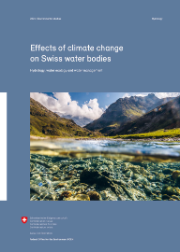The land surface forms the link between the atmosphere and water bodies and has fundamental importance in the hydrological system. As air temperatures rise, evaporation increases and the soil moisture reduces.

The soil is the most important water reservoir for vegetation because it retains the moisture necessary for growth, even in long periods without precipitation. The soil is also crucial for hydrology. Depending on the composition, structure and actual moisture content, the precipitation either drains quickly as surface runoff, is stored in the soil or percolates through it and reaches water bodies or groundwater with a temporal shift.
Water stored in the soil is released into the atmosphere by evaporation and soil moisture is reduced. Evaporation can take place directly from the surface of water and soil or by plant transpiration. Evaporation in turn influences precipitation formation, air temperature and atmospheric circulation.
There are gaps in the data for evaporation. The longest measurement series in Switzerland began in 1976 and comes from the ETH Zurich in the Toggenburg region. It was unable to establish any significant trend. Although measurements have been taken by many cantons and research institutions in the meantime, their objectives are often different. The measurement series are also too short for conclusions to be drawn regarding longer-term trends at this stage.
Soils drying out in summer
The rising temperatures resulting from climate change should theoretically lead to an increase in potential evaporation. How the actual evaporation at a specific location develops as temperatures rise depends on local water availability. Researchers expect to see an increase in average evaporation in Switzerland by the end of the century of 5% with climate change mitigation to 10% without climate change mitigation.
In the summer months the combination of lower precipitation and more evaporation makes the soil drier. In a scenario without climate change mitigation, an average of one millimetre less water per day in soil and runoff during the summer months can be expected in most regions by the end of the century. This equates to around 20% of the current average summer precipitation in Switzerland. During extreme droughts with a prolonged precipitation deficit, the reduction in water availability may be much greater.
Seasonal change in the indicator ‘Precipitation minus evaporation’ for Switzerland
Documents

The report ‘Effects of climate change on Swiss waters’ gives a concise overview of the results and is a gateway to further technical information and data.
Last modification 12.05.2021
Contact
Federal Office for the Environment FOEN
Hydrology Division
Papiermühlestr. 172
3063 Ittigen


![Seasonal change in the indicator ‘Precipitation minus evaporation’ (d[P–E]) for Switzerland](/nccs/en/home/sectors/water-management/auswirkungen-auf-den-wasserhaushalt/soil-moisture-and-evaporation/_jcr_content/par/image_1535938607/image.imagespooler.png/1620817927775/DE_Abb_4_4_Bodenwassergehalt_V05.png)
![Seasonal change in the indicator ‘Precipitation minus evaporation’ (d[P–E]) for Switzerland](/nccs/en/home/sectors/water-management/auswirkungen-auf-den-wasserhaushalt/soil-moisture-and-evaporation/_jcr_content/par/image_1535938607/image.imagespooler.png/1620817927775/1024.2000/DE_Abb_4_4_Bodenwassergehalt_V05.png)



